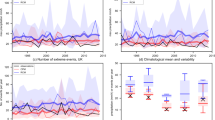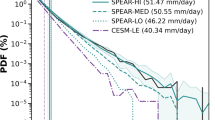Abstract
Extreme daily precipitation is thought to increase with temperature at a rate of 6.5% per K according to the Clausius–Clapeyron relationship between temperature and saturation vapour pressure1. A wide range of scaling relationships has been observed globally for extreme daily and hourly precipitation, with evidence of scaling above 6.5% per K for sub-daily extreme precipitation in some regions2,3,4. Only high-resolution climate models can simulate this scaling relationship5. Here we examine the scaling of hourly extreme precipitation intensities in a future climate using experiments with a model for the southern UK with kilometre-scale resolution6. Our model simulates the present-day scaling relationship at 6.5% per K, in agreement with observations. The simulated overall future increase in extreme precipitation follows the same relationship. However, UK extreme precipitation intensities decline at temperatures above about 22 °C—a temperature range that is not well sampled in the present-day integration—as a result of a more frequent occurrence of anticyclonic weather systems. Anticyclones produce more days with strong daytime heating, but are not favourable to the development of deep intense convective storms. We conclude that future extreme hourly precipitation intensities cannot simply be extrapolated from present-day temperature scaling, and demonstrate the pitfalls of using regional surface temperature as a scaling variable.
This is a preview of subscription content, access via your institution
Access options
Subscribe to this journal
Receive 12 print issues and online access
$259.00 per year
only $21.58 per issue
Buy this article
- Purchase on Springer Link
- Instant access to full article PDF
Prices may be subject to local taxes which are calculated during checkout



Similar content being viewed by others
References
Trenberth, K. E., Dai, A., Rasmussen, R. M. & Parsons, D. B. The changing character of precipitation. Bull. Am. Meteorol. Soc. 84, 1205–1217 (2003).
Lenderink, G. & van Meijgaard, E. Increase in hourly precipitation extremes beyond expectations from temperature changes. Nature Geosci. 1, 511–514 (2008).
Berg, P., Moseley, C. & Haerter, J. O. Strong increase in convective precipitation in response to higher temperatures. Nature Geosci. 6, 181–185 (2013).
Utsumi, N., Seto, S., Kanae, S., Maeda, E. E. & Oki, T. Does higher surface temperature intensify extreme precipitation? Geophys. Res. Lett. 38, L16708 (2011).
Ban, N., Schmidli, J. & Schär, C. Evaluation of the convection-resolving regional climate modeling approach in decade-long simulations. J. Geophys. Res. 119, 7889–7907 (2014).
Kendon, E. J. et al. Heavier summer downpours with climate change revealed by weather forecast resolution model. Nature Clim. Change 4, 570–576 (2014).
Westra, S., Alexander, L. V. & Zwiers, F. W. Global increasing trends in annual maximum daily precipitation. J. Clim. 26, 3904–3918 (2013).
Dai, A. Recent climatology, variability, and trends in global surface humidity. J. Clim. 19, 3589–3606 (2006).
Schneider, T. & O’Gorman, P. A. Moist convection and the thermal stratification of the extratropical troposphere. J. Atmos. Sci. 65, 3571–3583 (2008).
OGorman, P. A. & Schneider, T. The physical basis for increases in precipitation extremes in simulations of 21st-century climate change. Proc. Natl Acad. Sci. USA 106, 14773–14777 (2009).
Sugiyama, M., Shiogama, H. & Emori, S. Precipitation extreme changes exceeding moisture content increases in miroc and ipcc climate models. Proc. Natl Acad. Sci. USA 107, 571–575 (2009).
Arakawa, A. The cumulus parameterization problem: Past, present, and future. J. Clim. 17, 2493–2525 (2004).
Berg, P. & Haerter, J. O. Unexpected increase in precipitation intensity with temperature—a result of mixing of precipitation types? Atmos. Res. 119, 56–61 (2011).
Lenderink, G. & van Meijgaard, E. Linking increases in hourly precipitation extremes to atmospheric temperature and moisture changes. Environ. Res. Lett. 5, 025208 (2010).
Allen, M. R. & Ingram, W. J. Constraints on future changes in climate and the hydrologic cycle. Nature 419, 224–232 (2002).
Pall, P., Allen, M. R. & Stone, D. A. Testing the Clausius–Clapeyron constraint on changes in extreme precipitation under CO2 warming. Clim. Dynam. 28, 351–363 (2007).
Hardwick Jones, R., Westra, S. & Sharma, A. Observed relationships between extreme sub-daily precipitation, surface temperature, and relative humidity. Geophys. Res. Lett. 37, L22805 (2010).
Radermacher, C. & Tomassini, L. Thermodynamic causes for future trends in heavy precipitation over Europe based on an ensemble of regional climate model simulations. J. Clim. 25, 7669–7689 (2012).
Chan, S. C., Kendon, E. J., Fowler, H. J., Blenkinsop, S. & Roberts, N. M. Projected increases in summer and winter UK sub-daily precipitation extremes from high resolution regional climate models. Environ. Res. Lett. 9, 084019 (2014).
Blenkinsop, S., Chan, S. C., Kendon, E. J., Roberts, N. M. & Fowler, H. J. Temperature influences on intense UK hourly precipitation and dependency on large-scale circulation. Environ. Res. Lett. 10, 054021 (2015).
Kendon, E. J., Roberts, N. M., Senior, C. A. & Roberts, M. J. Realism of rainfall in a very high resolution regional climate model. J. Clim. 25, 5791–5806 (2012).
Mizielinski, M. S. et al. High resolution global climate modelling; the UPSCALE project, a large simulation campaign. Geosci. Model Dev. 7, 1629–1640 (2014); http://www.geosci-model-dev.net/7/1629/2014
Harrison, D. L., Driscoll, S. J. & Kitchen, M. Improving precipitation estimates from weather radar using quality control and correction techniques. Meteorol. Appl. 7, 135–144 (2000).
Ban, N., Schmidli, J. & Schär, C. Heavy precipitation in a changing climate: Does short-term summer precipitation increase faster? Geophys. Res. Lett. 42, 1165–1172 (2015).
Simmons, A. J., Willett, K. M., Jones, P. D., Thorne, P. W. & Dee, D. P. Low-frequency variations in surface atmospheric humidity, temperature, and precipitation: Inferences from reanalyses and monthly gridded observational data sets. J. Geophys. Res. 115, D01110 (2010).
Wright, J. S., Sobel, A. & Galewsky, J. Diagnosis of zonal mean relative humidity changes in a warmer climate. J. Clim. 23, 4556–4569 (2010).
Pfahl, S. & Wernli, H. Quantifying the relevance of cyclones for precipitation extremes. J. Clim. 25, 6770–6780 (2012).
van Vuuren, D. P. et al. The representative concentration pathways: An overview. Climatic Change 109, 5–31 (2011).
Perry, M., Hollis, D. & Elms, M. The Generation of Daily Gridded Datasets of Temperature and Rainfall for the UK (Met Office National Climate Information Centre, 2009).
Chan, S. C. et al. The value of high-resolution Met Office regional climate models in the simulation of multi-hourly precipitation extremes. J. Clim. 27, 6155–6174 (2014).
Overeem, A., Buishand, T. A. & Holleman, I. Extreme rainfall analysis and estimation of depth-duration-frequency curves using weather radar. Wat. Resour. Res. 45, W10424 (2009).
Cleveland, W. S. Robust locally weighted regression and smoothing scatterplots. J. Am. Stat. Assoc. 74, 829–836 (1979).
Mishra, V., Wallace, J. M. & Lettenmaier, D. P. Relationship between hourly extreme precipitation and local air temperature in the United States. Geophys. Res. Lett. 39, L16403 (2012).
Efron, B. & Tibshirani, R. J. An Introduction to the Bootstrap Vol. 57 (Monographs on Statistics and Applied Probability, Chapman and Hall, 1993).
IDL (Exelis Visual Information Solutions, 2009).
R Core Team R: A Language and Environment for Statistical Computing (R Foundation for Statistical Computing, 2013); http://www.R-project.org
Acknowledgements
This research is part of the projects CONVEX and INTENSE, and UKMO Hadley Centre research programme, which are supported by the United Kingdom NERC Changing Water Cycle programme (Grant no. NE/I006680/1), European Research Council (Grant no. ERC-2013-CoG), and the Joint Department of Energy and Climate Change and Department for Environment Food and Rural Affairs (Grant no. GA01101), respectively. S.C.C. is financially supported by Newcastle University, and is a visiting scientist at the UKMO Office Hadley Centre. H.J.F. is funded by the Wolfson Foundation and the Royal Society as a Royal Society Wolfson Research Merit Award (WM140025) holder. Significant portions of the analysis were carried out with the free and open-source statistical software R and its add-on library packages. We would also like to thank C. A. Ferro of the University of Exeter, M. J. Roberts and J. Wilkinson of the UKMO, and W. Moufouma-Okia of the United Nations Economic Commission for Africa (formerly Met Office) for their valuable inputs to this work.
Author information
Authors and Affiliations
Contributions
S.C.C. co-wrote the manuscript, conducted data analysis and data visualization. E.J.K. co-wrote the manuscript, supplied the data, performed the necessary model simulations, and advised on data analysis methodologies and result interpretation. N.M.R. co-wrote the manuscript, and advised on analysis methodologies and result interpretation. H.J.F. advised on the analysis methodologies, discussed the results, co-wrote the manuscript, and commented on the manuscript. S.B. advised on observational aspects of the present study, discussed the results, and commented on the manuscript.
Corresponding author
Ethics declarations
Competing interests
The authors declare no competing financial interests.
Supplementary information
Supplementary Information
Supplementary Information (PDF 2018 kb)
Rights and permissions
About this article
Cite this article
Chan, S., Kendon, E., Roberts, N. et al. Downturn in scaling of UK extreme rainfall with temperature for future hottest days. Nature Geosci 9, 24–28 (2016). https://doi.org/10.1038/ngeo2596
Received:
Accepted:
Published:
Issue Date:
DOI: https://doi.org/10.1038/ngeo2596
This article is cited by
-
Variability conceals emerging trend in 100yr projections of UK local hourly rainfall extremes
Nature Communications (2023)
-
Anthropogenic intensification of short-duration rainfall extremes
Nature Reviews Earth & Environment (2021)
-
The role of cyclonic activity in tropical temperature-rainfall scaling
Nature Communications (2021)
-
Observed response of precipitation intensity to dew point temperature over the contiguous US
Theoretical and Applied Climatology (2021)
-
The first multi-model ensemble of regional climate simulations at kilometer-scale resolution part 2: historical and future simulations of precipitation
Climate Dynamics (2021)



